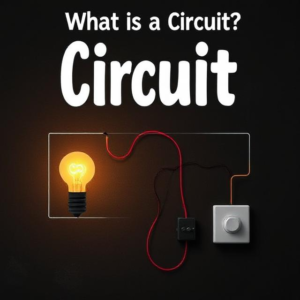Circuit design is like building a path for electricity to flow through so it can power devices or perform specific tasks, like turning on a light or making a sound.

1. What is a Circuit?
A circuit is just a loop or pathway that allows electricity to travel. It consists of different components connected together, like:
- Power Source: A battery or power outlet that provides electricity.
- Conductors: Wires that allow electricity to flow.
- Load: A device that uses the electricity (like a light bulb or motor).
- Switch: A component that can open or close the circuit, allowing or stopping the flow of electricity.
2. Types of Circuits:
There are two main types of circuits:
- Series Circuit: All the components are connected in a single path. If one part fails, the whole circuit stops working.
- Parallel Circuit: Components are connected in multiple paths. If one part fails, the rest can still work.
3. Basic Components:
In a circuit design, you typically use various components to control and direct the flow of electricity:
- Resistors: Control the flow of current by resisting it. This helps prevent components from getting damaged.
- Capacitors: Store energy temporarily and release it when needed.
- Transistors: Act like switches or amplifiers to control the flow of current in more complex circuits.
- Diodes: Allow current to flow in only one direction, protecting circuits from reverse current.
4. Designing a Circuit:
When designing a circuit, these steps are followed:
- Identify the Purpose: Decide what the circuit is supposed to do (e.g., light a bulb, amplify sound, etc.).
- Choose Components: Select the right components (like resistors, capacitors, etc.) based on your needs.
- Create a Schematic Diagram: This is like a blueprint for your circuit. It shows how all the components are connected together with symbols.
- Build the Circuit: After designing it on paper, you can build it physically on a breadboard (a tool for testing circuits) or by soldering the components onto a circuit board.
- Test the Circuit: Finally, you check if the circuit works as expected. If not, troubleshoot by looking for errors.
5. Simulation Tools:
Before actually building a circuit, engineers often use computer programs to simulate how it will work. These tools can help find problems and make sure the design is correct.
6. Practical Example:
Imagine you want to design a simple circuit to light up a bulb when you press a switch:
- Power Source: A battery.
- Conductors: Wires.
- Switch: A simple on-off switch.
- Load: A light bulb.
- Resistor: To limit the current so the bulb doesn’t burn out.
You’d connect the battery, the switch, the light bulb, and the resistor in the correct way. When you close the switch, the current flows through the circuit, and the light bulb lights up.
Conclusion:
Circuit design is all about understanding how electrical components work together to perform a specific function. Whether you’re building a simple flashlight or a complex computer, the basic principles of circuit design remain the same—creating a pathway for electricity to flow and ensuring everything works together safely and efficiently.
Tags: Advanced circuit design, Basic circuit design, battery, breadboard, capacitors, circuit, circuit blueprint, circuit board, circuit building, Circuit building process, Circuit Components, circuit construction, circuit design, Circuit design process, Circuit Design Software, Circuit design tools, Circuit diagram, Circuit function, circuit layout, Circuit Optimization, Circuit path, Circuit performance, Circuit schematic, Circuit Simulation, circuit testing, circuit troubleshooting, Components selection, conductors, Digital circuit design, Diodes, electric current flow, electrical circuit, electrical circuit design, electrical components, electrical control, electrical devices, electrical engineering, electrical power, electrical system design, electricity flow, electronics components, Electronics Design, electronics simulation, Engineering design, Light bulb circuit, load, Load devices, parallel circuit, power source, Practical circuit design, Resistors, series circuit, simple circuit design, Soldering, switch, Switch circuit, transistors, Troubleshooting Circuits, wires


